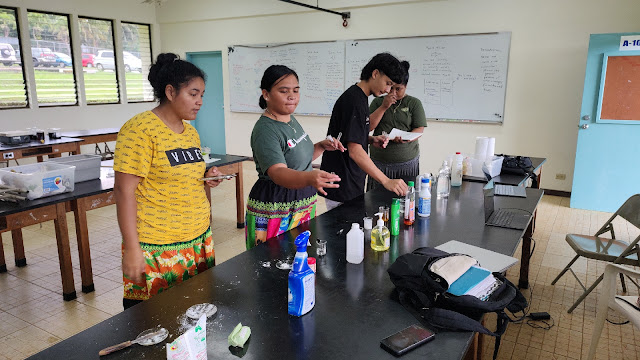Floral litmus solutions
The one week crash and dash through chemistry began with the periodic table.
I have learned to move slowly into this material, lingering up front with the basic concepts: the students either never encountered or have mostly forgotten everything about atoms. This term one student came up with proton and neutron, no one remembered the electron. But then electrons are inconsequentially small. Plus I cover the reason the atomic mass is not a whole number, isotopes, there only being two spin directions.
Wrapped up Monday with the geometry of the second period orbitals in three dimensions. Still not accurate, but conceptually easier to wrap ones mind around.
Wednesday I launched into bonding. At the end of class I added the floral notes at the bottom explaining to students as to what to bring. This actually helps: many brought red hibiscus and some brought red coleus, both of which perform well. Spathoglottis plicata still performs superbly.
This term I opted to move into dot notations to simplify diagrams.
This term I remembered to gather flowers and limes on Wednesday evening. The orchids can be seen on the right above. I also arrived early enough to preset the lab, get the notes onto the board, and have the water boiling by 8:30. This lab long ago dropped having the students go around looking for flowers. They usually bring back Ixora coccinea, which doesn't work. Or, this term, plumeria. Which also doesn't work.
Thursday morning I completed both boards prior to 8:00. These notes are the result of adjusting the tweaking directions and the lab for some 17 years. The biggest problem for years was that baking soda behaves anomalously - it is simply too weak a base or there is some interaction that prevents the color change from being as clear as it is for ammonia and other basic compounds. Abandoning baking soda as the known base has been a key contributor to student success in this laboratory.
The second board at 8:00 AM.
Shirlyann holds test tubes while Brenda makes determinations. Harriet and Lilly Rose observing.
Darx at the first station.
Margarette and Lomalinda team up to test unknowns.
Lomalinda works out what the unknown substance is called. The bottle is a calcium, lime, and rust removing compound.
Darx tests unknowns while Mahea records results.
The calcium, lime, and rust remover was perhaps the least familiar substance on the table.
Harriet and Lilly Rose working together.
Harriet records data while Lilly Rose performs tests.
Wrap notes on the board at 9:20 AM. This was far earlier than in prior terms, and is a reflection both the early setup, no searching for flowers, and everyone having working floral litmus solutions from early in the lab.
At 11:00 Lisa Praise and Leila Marie check their floral litmus solution for a color change when a known base is added, in this case dimethyl benzyl ammonium chloride.
Joyleen records results while Ciro tests for a color change for a known acid and a known base.
Leila Marie testing with a known base, Lisa Praise recording.
Leila Marie tests unknowns.
Lisa, Leila, Ciro, and Joyleen testing unknowns.

























Comments
Post a Comment